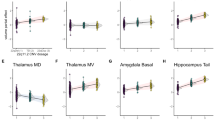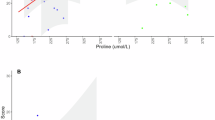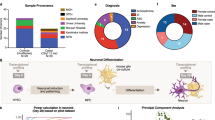Abstract
The association between the 22q11.2 deletion syndrome (22q11DS) and psychiatric disorders, particularly psychosis, suggests a causal relationship between 22q11DS genes and abnormal brain function. The genes catechol-O-methyl-transferase (COMT) and proline dehydrogenase both reside within the commonly deleted region of 22q11.2. COMT activity and proline levels may therefore be altered in 22q11DS individuals. Associations of both COMT158 genotype and elevated serum proline levels with abnormal brain function have been reported. Fifty-six 22q11DS children and 75 healthy controls were assessed on physiological measures of brain function, including prepulse inhibition (PPI) of startle, P50 auditory sensory gating and smooth pursuit eye movements (SPEM). COMT158 genotype and plasma proline levels were determined in the 22q11DS children. We hypothesized an interaction between the COMT158 genotype and proline, predicting the strongest negative effect of high proline on brain function to occur in 22q11DS children who are carriers of the COMTmet allele. Of the three physiological measures, only SPEM and PPI were abnormal in the patient sample. With regard to the SPEM performance, there was a significant interaction between the COMT158 genotype and proline level with significantly decreased SPEM performance in children with high plasma proline levels and the low activity COMTmet allele. A similar interaction effect was not observed with regard to PPI. These findings are consistent with a model in which elevated proline negatively affects brain function by an increase in dopamine in the prefrontal cortex. 22q11DS patients with low dopamine catabolic capacity are therefore especially vulnerable to this functional disruption.
Similar content being viewed by others
Log in or create a free account to read this content
Gain free access to this article, as well as selected content from this journal and more on nature.com
or
References
Abduljawad KA, Langley RW, Bradshaw CM, Szabadi E (1998). Effects of bromocriptine and haloperidol on prepulse inhibition of the acoustic startle response in man. J Psychopharmacol 12: 239–245.
Adler LE, Hoffer LD, Wiser A, Freedman R (1993). Normalization of auditory physiology by cigarette smoking in schizophrenic patients. Am J Psychiatry 150: 1856–1861.
Adler LE, Hoffer LJ, Griffith J, Waldo MC, Freedman R (1992). Normalization by nicotine of deficient auditory sensory gating in the relatives of schizophrenics. Biol Psychiatry 32: 607–616.
Antshel KM, Fremont W, Roizen NJ, Shprintzen R, Higgins AM, Dhamoon A et al (2006). ADHD, major depressive disorder, and simple phobias are prevalent psychiatric conditions in youth with velocardiofacial syndrome. J Am Acad Child Adolesc Psychiatry 45: 596–603.
Baker K, Baldeweg T, Sivagnanasundaram S, Scambler P, Skuse D (2005). COMT Val108/158 Met modifies mismatch negativity and cognitive function in 22q11 deletion syndrome. Biol Psychiatry 58: 23–31.
Baker KD, Skuse DH (2005). Adolescents and young adults with 22q11 deletion syndrome: psychopathology in an at-risk group. Br J Psychiatry 186: 115–120.
Bearden CE, Jawad AF, Lynch DR, Sokol S, Kanes SJ, McDonald-McGinn DM et al (2004). Effects of a functional COMT polymorphism on prefrontal cognitive function in patients with 22q11.2 deletion syndrome. Am J Psychiatry 161: 1700–1702.
Bender HU, Almashanu S, Steel G, Hu CA, Lin WW, Willis A et al (2005). Functional consequences of PRODH missense mutations. Am J Hum Genet 76: 409–420.
Braff DL, Light GA, Swerdlow NR (2007). Prepulse inhibition and P50 suppression are both deficient but not correlated in schizophrenia patients. Biol Psychiatry 61: 1204–1207.
Chen J, Lipska BK, Halim N, Ma QD, Matsumoto M, Melhem S et al (2004). Functional analysis of genetic variation in catechol-O-methyltransferase (COMT): effects on mRNA, protein, and enzyme activity in postmortem human brain. Am J Hum Genet 75: 807–821.
Cohen SM, Nadler JV (1997a). Proline-induced potentiation of glutamate transmission. Brain Res 761: 271–282.
Cohen SM, Nadler JV (1997b). Proline-induced inhibition of glutamate release in hippocampal area CA1. Brain Res 769: 333–339.
Crump FT, Fremeau RT, Craig AM (1999). Localization of the brain-specific high-affinity L-proline transporter in cultured hippocampal neurons: molecular heterogeneity of synaptic terminals. Mol Cell Neurosci 13: 25–39.
Edelmann L, Pandita RK, Spiteri E, Funke B, Goldberg R, Palanisamy N et al (1999). A common molecular basis for rearrangement disorders on chromosome 22q11. Hum Mol Genet 8: 1157–1167.
Fine SE, Weissman A, Gerdes M, Pinto-Martin J, Zackai EH, McDonald-McGinn DM et al (2005). Autism spectrum disorders and symptoms in children with molecularly confirmed 22q11.2 deletion syndrome. J Autism Dev Disord 35: 461–470.
Fremeau Jr RT, Caron MG, Blakely RD (1992). Molecular cloning and expression of a high affinity L-proline transporter expressed in putative glutamatergic pathways of rat brain. Neuron 8: 915–926.
Glaser B, Debbane M, Hinard C, Morris MA, Dahoun SP, Antonarakis SE et al (2006). No evidence for an effect of COMT Val158Met genotype on executive function in patients with 22q11 deletion syndrome. Am J Psychiatry 163: 537–539.
Gogos JA, Santha M, Takacs Z, Beck KD, Luine V, Lucas LR et al (1999). The gene encoding proline dehydrogenase modulates sensorimotor gating in mice. Nat Genet 21: 434–439.
Goodman BK, Rutberg J, Lin WW, Pulver AE, Thomas GH (2000). Hyperprolinaemia in patients with deletion (22)(q11.2) syndrome. J Inherit Metab Dis 23: 847–848.
Gothelf D, Eliez S, Thompson T, Hinard C, Penniman L, Feinstein C et al (2005). COMT genotype predicts longitudinal cognitive decline and psychosis in 22q11.2 deletion syndrome. Nat Neurosci 8: 1500–1502.
Gothelf D, Presburger G, Zohar AH, Burg M, Nahmani A, Frydman M et al (2004). Obsessive-compulsive disorder in patients with velocardiofacial (22q11 deletion) syndrome. Am J Med Genet 126B: 99–105.
Grunwald T, Boutros NN, Pezer N, von Oertzen J, Fernandez G, Schaller C et al (2003). Neuronal substrates of sensory gating within the human brain. Biol Psychiatry 53: 511–519.
Hutchison KE, Swift R (1999). Effect of D-amphetamine on prepulse inhibition of the startle reflex in humans. Psychopharmacology (Berl) 143: 394–400.
Kates WR, Antshel KM, Abdulsabur N, Colgan D, Funke B, Fremont W et al (2006). A gender-moderated effect of a functional COMT polymorphism on prefrontal brain morphology and function in velo-cardio-facial syndrome (22q11.2 deletion syndrome). Am J Med Genet B Neuropsychiatr Genet 141: 274–280.
Knight RT, Staines WR, Swick D, Chao LL (1999). Prefrontal cortex regulates inhibition and excitation in distributed neural networks. Acta Psychol (Amst) 101: 159–178.
Kodsi MH, Swerdlow NR (1997). Mitochondrial toxin 3-nitropropionic acid produces startle reflex abnormalities and striatal damage in rats that model some features of Huntington's disease. Neurosci Lett 231: 103–107.
Kurthen M, Trautner P, Rosburg T, Grunwald T, Dietl T, Kuhn KU et al (2007). Towards a functional topography of sensory gating areas: invasive P50 recording and electrical stimulation mapping in epilepsy surgery candidates. Psychiatry Res 155: 121–133.
Lachman HM, Papolos DF, Saito T, Yu YM, Szumlanski CL, Weinshilboum RM (1996). Human catechol-O-methyltransferase pharmacogenetics: description of a functional polymorphism and its potential application to neuropsychiatric disorders. Pharmacogenetics 6: 243–250.
Martin D, Ault B, Nadler JV (1992). NMDA receptor-mediated depolarizing action of proline on CA1 pyramidal cells. Eur J Pharmacol 219: 59–66.
Matsumoto M, Weickert CS, Akil M, Lipska BK, Hyde TM, Herman MM et al (2003). Catechol-O-methyltransferase mRNA expression in human and rat brain: evidence for a role in cortical neuronal function. Neuroscience 116: 127–137.
Mattay VS, Goldberg TE, Fera F, Hariri AR, Tessitore A, Egan MF et al (2003). Catechol-O-methyltransferase val158-met genotype and individual variation in the brain response to amphetamine. Proc Natl Acad Sci USA 100: 6186–6191.
Moghaddam B (2002). Stress activation of glutamate neurotransmission in the prefrontal cortex: implications for dopamine-associated psychiatric disorders. Biol Psychiatry 51: 775–787.
Murphy KC, Jones LA, Owen MJ (1999). High rates of schizophrenia in adults with velo-cardio-facial syndrome. Arch Gen Psychiatry 56: 940–945.
Nagel M, Sprenger A, Hohagen F, Binkofski F, Lencer R (2008). Cortical mechanisms of retinal and extraretinal smooth pursuit eye movements to different target velocities. Neuroimage 41: 483–492.
Niklasson L, Rasmussen P, Oskarsdottir S, Gillberg C (2001). Neuropsychiatric disorders in the 22q11 deletion syndrome. Genet Med 3: 79–84.
Oosterhuis BE, Laforge KS, Proudnikov D, Ho A, Nielsen DA, Gianotti R et al (2008). Catechol-O-methyltransferase (COMT) gene variants: Possible association of the Val158Met variant with opiate addiction in hispanic women. Am J Med Genet B Neuropsychiatr Genet. Feb 12. [E-pub ahead of print]
Paterlini M, Zakharenko SS, Lai WS, Qin J, Zhang H, Mukai J et al (2005). Transcriptional and behavioral interaction between 22q11.2 orthologs modulates schizophrenia-related phenotypes in mice. Nat Neurosci 8: 1586–1594.
Raux G, Bumsel E, Hecketsweiler B, van Amelsvoort T, Zinkstok J, Manouvrier-Hanu S et al (2006). Involvement of hyperprolinemia in cognitive and psychiatric features of the 22q11 deletion syndrome. Hum Mol Genet 16: 83–91.
Renick SE, Kleven DT, Chan J, Stenius K, Milner TA, Pickel VM et al (1999). The mammalian brain high-affinity L-proline transporter is enriched preferentially in synaptic vesicles in a subpopulation of excitatory nerve terminals in rat forebrain. J Neurosci 19: 21–33.
Roussos P, Giakoumaki SG, Bitsios P (2008). The dopamine D(3) receptor Ser9Gly polymorphism modulates prepulse inhibition of the acoustic startle reflex. Biol Psychiatry 64: 235–240.
Schwarzkopf SB, Lamberti JS, Smith DA (1993). Concurrent assessment of acoustic startle and auditory P50 evoked potential measures of sensory inhibition. Biol Psychiatry 33: 815–828.
Shaikh TH, Kurahashi H, Saitta SC, O'Hare AM, Hu P, Roe BA et al (2000). Chromosome 22-specific low copy repeats and the 22q11.2 deletion syndrome: genomic organization and deletion endpoint analysis. Hum Mol Genet 9: 489–501.
Shashi V, Keshavan MS, Howard TD, Berry MN, Basehore MJ, Lewandowski E et al (2006). Cognitive correlates of a functional COMT polymorphism in children with 22q11.2 deletion syndrome. Clin Genet 69: 234–238.
Sheehan DV, Lecrubier Y, Sheehan KH, Amorim P, Janavs J, Weiller E et al (2007). The Mini-International Neuropsychiatric Interview (M.I.N.I.): the development and validation of a structured psychiatric interview for DSM-IV and ICD-10. J Clin Psychiatry 59: 22–33.
Sobin C, Kiley-Brabeck K, Karayiorgou M (2005). Lower prepulse inhibition in children with the 22q11 deletion syndrome. Am J Psychiatry 162: 1090–1099.
Swerdlow NR, Paulsen J, Braff DL, Butters N, Geyer MA, Swenson MR (1995). Impaired prepulse inhibition of acoustic and tactile startle response in patients with Huntington's disease. J Neurol Neurosurg Psychiatry 58: 192–200.
Tanabe J, Tregellas JR, Martin LF, Freedman R (2006). Effects of nicotine on hippocampal and cingulate activity during smooth pursuit eye movement in schizophrenia. Biol Psychiatry 59: 754–761.
Thaker GK (2008). Neurophysiological endophenotypes across bipolar and schizophrenia psychosis. Schizophr Bull 34: 760–773.
Thaker GK, Wonodi I, Avila MT, Hong LE, Stine OC (2004). Catechol-O-methyltransferase polymorphism and eye tracking in schizophrenia: a preliminary report. Am J Psychiatry 161: 2320–2322.
Tregellas JR, Tanabe JL, Miller DE, Ross RG, Olincy A, Freedman R (2004). Neurobiology of smooth pursuit eye movement deficits in schizophrenia: an fMRI study. Am J Psychiatry 161: 315–321.
Turetsky BI, Calkins ME, Light GA, Olincy A, Radant AD, Swerdlow NR (2007). Neurophysiological endophenotypes of schizophrenia: the viability of selected candidate measures. Schizophr Bull 33: 69–94.
van Vliet IM, Leroy H, van Megen HJGM (2000). De M.I.N.I. Internationaal Neuropsychiatrisch Interview, Nederlandse Versie 5.0.0. Leiden University Medical Center, Department of Psychiatry, The Netherlands.
Vorstman JAS, Morcus MEJ, Duijff SN, Klaassen PWJ, Heineman-de Boer JA, Beemer FA et al (2006). The 22q11.2 deletion in children: high rate of autistic disorders and early onset of psychotic symptoms. J Am Acad Child Adolesc Psychiatry 45: 1104–1113.
Wechsler D, Kort W, Compaan EL, Bliechrodt N, Resig WCM, Schittekatte M et al (2002). WISC-III NL, Handleiding. Psychological Corporation: London.
Acknowledgements
JAS Vorstman M.D., Ph.D. was supported by a 2006 NARSAD Young Investigator Award, funded by Stephen and Constance Lieber.
Author information
Authors and Affiliations
Corresponding author
Additional information
DISCLOSURE/CONFLICT OF INTEREST
None.
Supplementary Information accompanies the paper on the Neuropsychopharmacology website (http://www.nature.com/npp)
Supplementary information
Rights and permissions
About this article
Cite this article
Vorstman, J., Turetsky, B., Sijmens-Morcus, M. et al. Proline Affects Brain Function in 22q11DS Children with the Low Activity COMT158 Allele. Neuropsychopharmacol 34, 739–746 (2009). https://doi.org/10.1038/npp.2008.132
Received:
Revised:
Accepted:
Published:
Issue date:
DOI: https://doi.org/10.1038/npp.2008.132
Keywords
This article is cited by
-
Event-related potential (ERP) markers of 22q11.2 deletion syndrome and associated psychosis
Journal of Neurodevelopmental Disorders (2023)
-
A genetics-first approach to understanding autism and schizophrenia spectrum disorders: the 22q11.2 deletion syndrome
Molecular Psychiatry (2023)
-
Metabolic signature of the pathogenic 22q11.2 deletion identifies carriers and provides insight into systemic dysregulation
Translational Psychiatry (2023)
-
Haploinsufficiency of the HIRA gene located in the 22q11 deletion syndrome region is associated with abnormal neurodevelopment and impaired dendritic outgrowth
Human Genetics (2021)
-
Affective and psychotic reactivity to daily-life stress in adults with 22q11DS: a study using the experience sampling method
Journal of Neurodevelopmental Disorders (2020)



